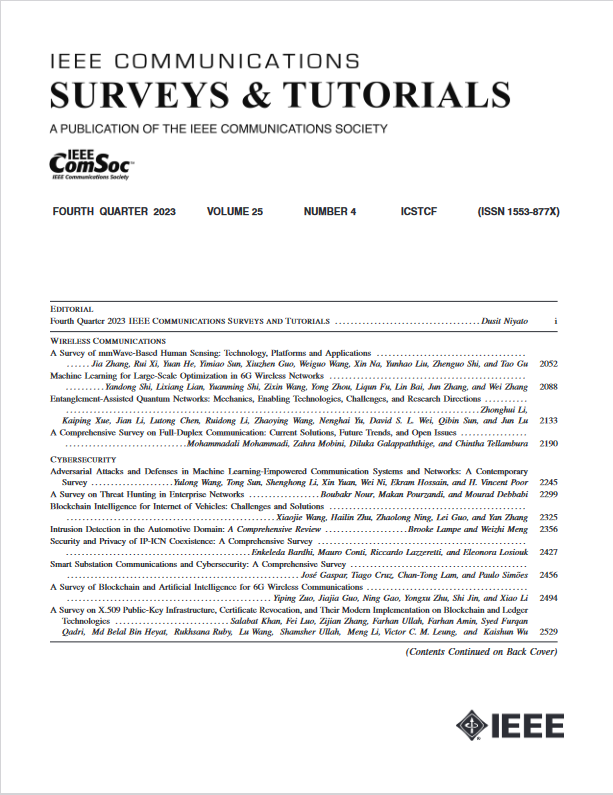Domain Generalization in Machine Learning Models for Wireless Communications: Concepts, State-of-the-Art, and Open Issues
IF 34.4
1区 计算机科学
Q1 COMPUTER SCIENCE, INFORMATION SYSTEMS
引用次数: 2
Abstract
Data-driven machine learning (ML) is promoted as one potential technology to be used in next-generation wireless systems. This led to a large body of research work that applies ML techniques to solve problems in different layers of the wireless transmission link. However, most of these applications rely on supervised learning which assumes that the source (training) and target (test) data are independent and identically distributed (i.i.d). This assumption is often violated in the real world due to domain or distribution shifts between the source and the target data. Thus, it is important to ensure that these algorithms generalize to out-of-distribution (OOD) data. In this context, domain generalization (DG) tackles the OOD-related issues by learning models on different and distinct source domains/datasets with generalization capabilities to unseen new domains without additional finetuning. Motivated by the importance of DG requirements for wireless applications, we present a comprehensive overview of the recent developments in DG and the different sources of domain shift. We also summarize the existing DG methods and review their applications in selected wireless communication problems, and conclude with insights and open questions.无线通信机器学习模型的领域泛化:概念、最新技术和开放问题
数据驱动的机器学习(ML)被认为是下一代无线系统的潜在技术之一。这导致了大量的研究工作,应用机器学习技术来解决无线传输链路的不同层的问题。然而,大多数这些应用程序依赖于监督学习,它假设源(训练)和目标(测试)数据是独立和同分布的(i.i.d)。在现实世界中,由于源数据和目标数据之间的域或分布变化,这个假设经常被违背。因此,确保这些算法推广到分布外(OOD)数据是很重要的。在这种情况下,域泛化(DG)通过在不同的和不同的源域/数据集上学习模型来解决ood相关的问题,这些模型具有对未见过的新域的泛化能力,而无需额外的微调。由于无线应用中DG要求的重要性,我们对DG的最新发展和不同的域转移来源进行了全面概述。我们还总结了现有的DG方法,并回顾了它们在选定的无线通信问题中的应用,最后提出了见解和悬而未决的问题。
本文章由计算机程序翻译,如有差异,请以英文原文为准。
求助全文
约1分钟内获得全文
求助全文
来源期刊

IEEE Communications Surveys and Tutorials
COMPUTER SCIENCE, INFORMATION SYSTEMS-TELECOMMUNICATIONS
CiteScore
80.20
自引率
2.50%
发文量
84
审稿时长
6 months
期刊介绍:
IEEE Communications Surveys & Tutorials is an online journal published by the IEEE Communications Society for tutorials and surveys covering all aspects of the communications field. Telecommunications technology is progressing at a rapid pace, and the IEEE Communications Society is committed to providing researchers and other professionals the information and tools to stay abreast. IEEE Communications Surveys and Tutorials focuses on integrating and adding understanding to the existing literature on communications, putting results in context. Whether searching for in-depth information about a familiar area or an introduction into a new area, IEEE Communications Surveys & Tutorials aims to be the premier source of peer-reviewed, comprehensive tutorials and surveys, and pointers to further sources. IEEE Communications Surveys & Tutorials publishes only articles exclusively written for IEEE Communications Surveys & Tutorials and go through a rigorous review process before their publication in the quarterly issues.
A tutorial article in the IEEE Communications Surveys & Tutorials should be designed to help the reader to become familiar with and learn something specific about a chosen topic. In contrast, the term survey, as applied here, is defined to mean a survey of the literature. A survey article in IEEE Communications Surveys & Tutorials should provide a comprehensive review of developments in a selected area, covering its development from its inception to its current state and beyond, and illustrating its development through liberal citations from the literature. Both tutorials and surveys should be tutorial in nature and should be written in a style comprehensible to readers outside the specialty of the article.
 求助内容:
求助内容: 应助结果提醒方式:
应助结果提醒方式:


